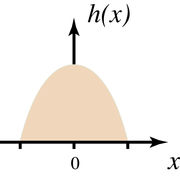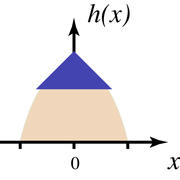Difference between revisions of "Practice problems/A man with a quadratically shaped head"
From UBCMATH WIKI
| Line 1: | Line 1: | ||
[[Image:Math102QuadHeadNoHat.png|left|thumb|'''Figure 1'''. The man's head without the hat.]] [[Image:Math102QuadHead.png|thumb|'''Figure 2'''. The man's head with the hat.]] | [[Image:Math102QuadHeadNoHat.png|left|thumb|'''Figure 1'''. The man's head without the hat.]] [[Image:Math102QuadHead.png|thumb|'''Figure 2'''. The man's head with the hat.]] | ||
| − | A man with a quadratically shaped head, with profile given by the function | + | A man with a quadratically shaped head, with profile given by the function $h(x)=4-3x^2$ where both $x$ and $h(x)$ are measured in decimetres, puts on a conical hat whose profile has a right angle at the tip. How much taller does he appear with the hat on if he wears the hat symmetrically? What are the coordinates of the point at which the hat touches his head. |
Latest revision as of 13:42, 11 June 2014
A man with a quadratically shaped head, with profile given by the function $h(x)=4-3x^2$ where both $x$ and $h(x)$ are measured in decimetres, puts on a conical hat whose profile has a right angle at the tip. How much taller does he appear with the hat on if he wears the hat symmetrically? What are the coordinates of the point at which the hat touches his head.

